The Price of Water: A Comparison of Water Rates, Usage in 30 U.S. Cities
Across the country there is wide variation in use and price for water consumption in major urban areas, with residential rates being lowest in the Great Lakes region, according to a Circle of Blue survey.
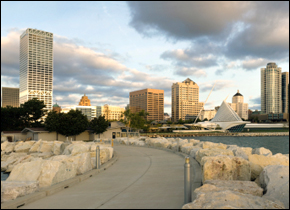
By Brett Walton
Circle of Blue
A first of its kind survey of residential water use and prices in 30 metropolitan regions in the United States has found that some cities in rain-scarce regions have the lowest residential water rates and the highest level of water use. A family of four using 100 gallons per person each day will pay on average $34.29 a month in Phoenix compared to $65.47 for the same amount in Boston.
The survey, conducted by Circle of Blue over the last several months, also found that average daily residential water use ranged from a low of 41 gallons per person in Boston to a high of 211 gallons per person in Fresno, Calif.
The Circle of Blue survey includes data on water rates and water usage from the 20 largest U.S. cities, according to the 2000 Census, and ten regionally representative cities to gain a broad view of urban water pricing. The survey comes as municipal water departments and their customers across the country contend with the ironic and unintended consequence of the economic recession and water conservation. In most major cities water use is declining while rates charged to residential customers are rising.
The effect of the crossing trends is less severe in Chicago, Detroit and Milwaukee, where municipal water is supplied by the lakes and prices range from $24.12 to $28.36.
“The reason why rates are so low in the Great Lakes region is proximity to abundant water,” said Nick Schroeck, executive director of the Great Lakes Environmental Law Center in Detroit. “Moving water takes an extraordinary amount of energy. Energy costs are higher in arid regions where water has to be brought from far away. For us, you look at the larger cities, and they are right on one of the lakes. It’s easy to get water to the population centers.”
Even though prices are comparatively low, rates in the Great Lakes region have increased in recent years because of declining consumption. Most of that decrease is attributed to the loss of industrial activity, though shrinking urban populations and personal frugality are also factors.
-Richard Meeusen, WAVE Founder
Falling demand is a concern for Carrie Lewis, the superintendent of Milwaukee Water Works, because the utility’s revenue comes from water sales, so less use means higher rates. In an interview, Lewis described a downward-sloping graph showing the decrease in water sales over the last three decades. Sales in Milwaukee dropped 41 percent from 1976 to 2008, primarily because water-intensive breweries and tanneries went out of business or left town.
“That’s a frightening graph if you make money selling water,” Lewis said.
As a result, water conservation is not a big part of Milwaukee’s agenda. Milwaukee Water Works (MWW) rejected a suggestion from the state public service commission to institute a block tariff rate structure, which would have raised prices for high-volume users to encourage using less water. The city is actually looking to increase water use because of its spare infrastructure capacity and ample supply.
“MWW could double its customer base without having to build new facilities,” Lewis said. “There’s no capital cost to avoid by increasing water use.”
To that end, some Milwaukee businesses want the city to fish for industry with the lure of cheap water, according to an article from the American Water Works Association. Business owner Richard Meeusen started the group Water Attracting Valued Employers (WAVE) to lobby for a discounted industrial water rate.
“For more than 20 years industry has been moving south looking for cheaper labor, I’m hoping that now they’ll start coming back looking for cheaper water,” Meeusen told the AWWA.
Water demand in Milwaukee is similar to urban areas across the United States. Per capita water use is dropping in nearly every city surveyed, and total water use has fallen or remains steady in some cities despite population bulges.
Infographic: Water Use Comparison of 5 U.S. Cities
Water in the Southwest
Declines in demand are especially notable in arid cities of the Southwest and southern California. These regions binged in the 20th century on relatively abundant supplies brought from afar, using water to leverage growth. But as populations have disproportionately grown in comparison to the available supply, cities are cutting back to avoid building costly desalination plants, investing in diversion schemes or buying expensive water through market exchanges.
Per capita use in Santa Fe has dropped 42 percent since 1995 and total use is down nearly 30 percent, while Phoenix consumes the same amount of water now as it did 10 years ago despite adding roughly 400,000 residents. Figures released two weeks ago from the Los Angeles Department of Water and Power show that it supplied less water in February than any time in the last three decades, according to the Los Angeles Times.
Las Vegas has significantly cut outdoor water use by prohibiting front lawns for new houses since 2003. As a result, water deliveries from the Southern Nevada Water Authority, which supplies Las Vegas, dropped by 20 billion gallons from 2002 to 2003–enough water to cover the annual residential needs of a city of 150,000.
People living in the Southwest are often excoriated for their water use, but critics neglect the necessity for water, argues Stephanie Duer, water conservation program coordinator for Salt Lake City Public Utilities.
“I never hear people complain about Alaska or Connecticut using too much heating oil,” Duer said in an interview. “It seems to me that since we’re in a dry region we will be using more water.”
Water use needs to be weighed against the other benefits it provides, Duer added. “I hear people say ‘Why don’t you plant native species’ Well, We don’t have a single shade tree that would grow at this elevation. Do you want to live in a city without trees? We want to keep the urban forest for quality of life and keeping shade helps to reduce energy use in the summer. We’re working hard to find that balance in water use.”
-Drew Beckwith
Though water supplies are precious in these places, the price of water for residential customers is relatively cheap. A family of four using 100 gallons per person each day will pay on average $32.93 a month in Las Vegas compared to $72.95 for the same amount in Atlanta, which has more than ten times the amount of average annual rainfall as Las Vegas, according to National Weather Service statistics. While many factors contribute to water pricing, such as the energy used to pump water, the price of chemicals for treatment costs, recent infrastructure projects and operations efficiency–the difference in several Western cities can partly be explained by government subsidy.
“In the West there was massive federal investment in major water infrastructure,” said Heather Cooley, a researcher for the Pacific Institute’s water program. “Those states and cities didn’t have to pay the capital cost. California’s Central Valley Project is an example of that. The capital cost not including interest still hasn’t been paid, and that was built over 50 years ago. The subsidies create an artificial price.”
Water delivered via the Central Valley Project, a federal initiative led by the Bureau of Reclamation, is primarily directed toward agriculture. The same federal support helped build the Central Arizona Project, a canal that connects water from the Colorado River to Phoenix, Tucson and other cities in three Arizona counties.
Residents of those cities who benefit from this lifeline channeled through the Sonoran Desert are paying only 45 percent of the project’s $3.6 billion cost. The difference is a national burden.
The Central Arizona Project, Hoover Dam, California’s State Water Project, Colorado’s Big Thompson Project are all water supply diversions paid for in part by federal or state tax funds. But when new supply projects are financed by customers directly, higher water rates are the consequence.
Take Santa Fe, for example.
The city has the highest overall rates in the survey and the highest rates for high-volume users. Because water is scarce and current groundwater use is unsustainable, the city is building the $217 million Buckman Direct Diversion to tap water from the San Juan-Chama diversion. It is a non-federal project, and the $187 million after-grant cost is being jointly paid by the city and the county.
While Santa Fe’s supply project meets current needs, high-growth areas typically levy a one-time connection fee on new development to place the burden on newcomers for acquiring anticipated supplies or building treatment. In Las Vegas, for example, residents buying new houses would pay $1,440 to the Las Vegas Valley Water District and $4,870 to the regional supplier, the Southern Nevada Water Authority.
“Most of the infrastructure is paid for by new customers,” said Doug Bennett, SNWA’s conservation manager. “There’s not a lot of infrastructure dollars in the water rate.”
Growth in Las Vegas has slowed in the last few years because of the economic crisis and the housing bubble implosion. Water utilities are not getting many connection fees-–down to 1,139 in 2008 from a high of just over 24,000 in 2005. Slower expansion means the city does not have to worry about meeting constantly rising demand.
“Instead of worrying about meeting next year’s capacity, now there’s plenty,” said Matt Thorley, principal financial manager for LVVWD.
The Future of Water Prices
In many cities, residents lean on infrastructure investments made in the years following World War II. The strain shows. According to the Environmental Protection Agency, 240,000 water main breaks occur each year. Leaky pipes lose billions of dollars of treated water annually, and sewer overflows cause outbreaks of disease.
Last year the EPA estimated that $335 billion would be needed to fix the country’s aging water supply system in the next few decades, according to the New York Times. But where that money will come from is unknown.
According to Jack Moss, an advisor to Aquafed, the international water industry association, cities have to decide whether to make improvements through taxes or tariffs. The problem is that neither government spending nor higher water bills gather much voting support.
Despite the hand wringing over prices, water in the U.S. remains cheap. In most cities surveyed by Circle of Blue a family of four can buy enough water for its indoor needs–50 gallons per person per day for washing, drinking, cooking and flushing–for less than $25 per month, which is a relatively small portion of a family budget.
“Water is very reasonably priced,” said Doug Bennett, conservation manager for the Southern Nevada Water Authority. “[As a result], it’s not a major expense on people’s radar screen.”
Meanwhile when prices come up for discussion there are always social justice concerns about access for the poor. However, with a few exceptions such as Detroit, most cities have adequate financial assistance programs to ensure in-home access for all.
One barrier to better water management is communication between utilities and customers–a common chorus amongst water rate researchers interviewed for this article.
“Water use is generally not publicized much outside of droughts,” said Drew Beckwith, a water specialist with Western Resource Advocates. “Water sort of has a technical side that often doesn’t get communicated well to the public.”
Another problem may be habit. Water has generally been so cheap for so long, that people have become anchored to the past price, not realizing that sustainability costs money to achieve.
Prices will undoubtedly rise in the near future. But the question of whether the increase comes via higher taxes or tariffs remains because bearing the price of doing nothing would be much worse.
Note: Water rate information was gathered from the website of each city’s water utility and based on single-family residential rates. It is current as of April 1. Average prices for cities with seasonal rates were calculated using seasonal weighting. For water use information, Circle of Blue asked water departments directly the daily per capita usage for single- and multi-family residential customers.
Brett Walton is a reporter for Circle of Blue. This is the second part of his investigation on U.S. urban water rates–read the first installment here as well as a profile on water pricing issues in Detroit here. All graphics were created by Trevor Seela. Contact Brett Walton
Brett writes about agriculture, energy, infrastructure, and the politics and economics of water in the United States. He also writes the Federal Water Tap, Circle of Blue’s weekly digest of U.S. government water news. He is the winner of two Society of Environmental Journalists reporting awards, one of the top honors in American environmental journalism: first place for explanatory reporting for a series on septic system pollution in the United States(2016) and third place for beat reporting in a small market (2014). He received the Sierra Club’s Distinguished Service Award in 2018. Brett lives in Seattle, where he hikes the mountains and bakes pies. Contact Brett Walton

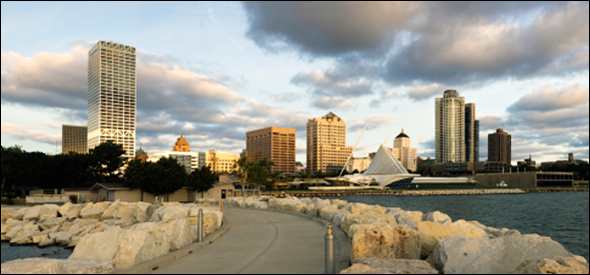
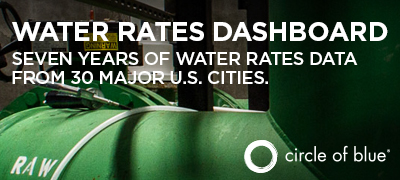
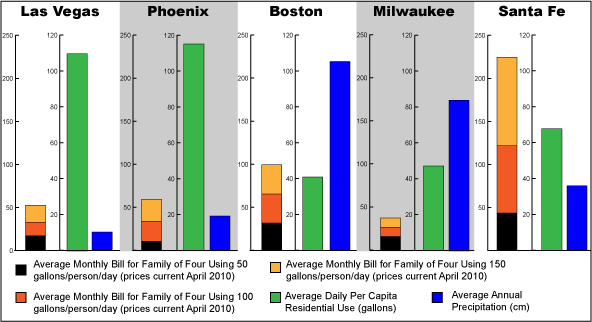
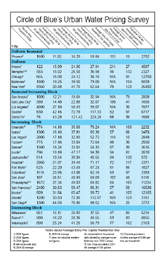

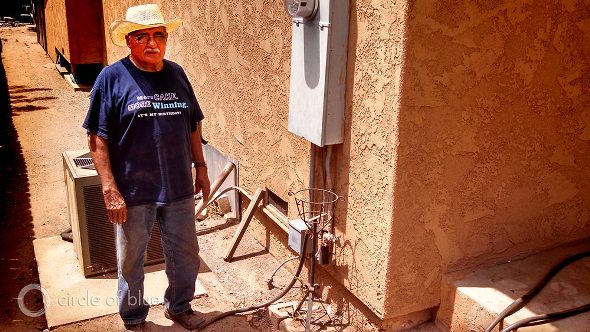
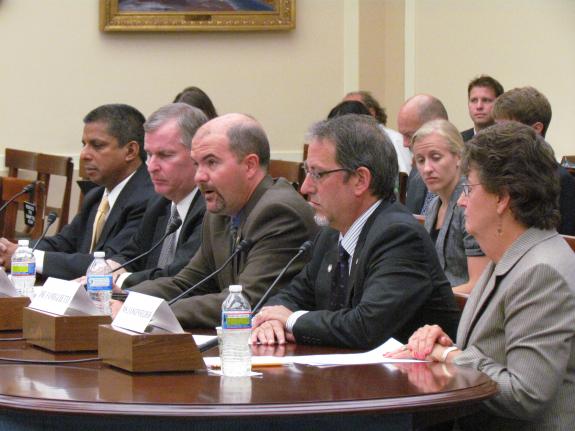

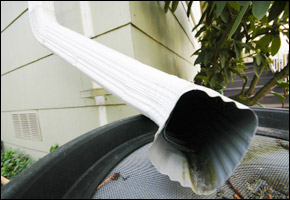


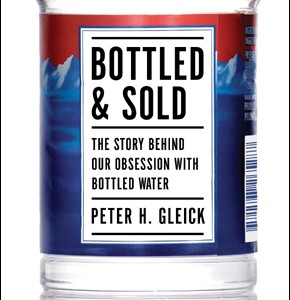
Great post Bret! I am not sure if you put enough emphasis on connection between price and cost of service NOT scarcity. “Though water supplies are precious in these places, the price of water for residential customers is relatively cheap.” is because infrastructure is cheap, NOT water. Vegas prices are low — even while Lake Mead drains — because Vegas residents do not face a scarcity price for their water. Increasing block rates encourage conservation, but they often have little to do with scarcity. Vegas IBRs, btw, are steep but they kick in WAYY late to encourage conservation for most folks.
Brett, thanks for collecting this data. If you plot population density vs. Monthly Billing by water use (ppl/mi2 vs. billing for 50 gpd, 100 gpd, 150 gpd)), and take the slope of the upper envelope, I get a cost reduction of $1/1000 ppl. for the 50 gpd vs. $6/1000 ppl. for the 150 gpd users;100 gpd falls in between at about $3/1000 ppl.
A couple of things from this: the inefficient water users are paying more (or subsidizing those using less water), and water costs go down with higher population densities (perhaps due to higher infra-structure in more populated areas).
Big assumption: the 50 gpd, 100 gpd, & 150 gpd data sets are independent(!).
Brett
I appreciated the article on the price of water in U.S. cities. Is it possible that you might be willing to send me the data in spreadsheet format?
Thanks.
-Spreck
Domestic use of water is calculated in differnt sosietis What should be the standard for gallons/day-person & what is standard use in industry, like textile, chemical and others comparatively
““That’s a frightening graph if you make money selling water,” Lewis said.”
That’s so backwards it blows my mind. The municipality shouldn’t be about making money. It should scale back if costs are high – NOT rais rates.
On the other hand, the consumption in Vegas and Phoenix blows my mind. They should triple the rates there. Sorry guys, you live in a desert. Deal with it.
This is a good article, I especially liked the quote about “Water use is generally not publicized much outside of droughts. However, I feel that you are reaching a bit when you say that it is the “first of its kind survey.”I have been reading, researching and presenting on this topic for nearly all of my 22 years of working with public water systems and I have come across numerous similar studies. A couple comments: 1) There really is no mention of the fact that water users may be using less water not only to reduce their water bill but to reduce their sewer bill. Most sewer rates are tied to water use; therefore, users have a double incentive to reduce water use – they will cut their water bill and they will also cut their sewer bill. 2) Water use trends may also be declining simply by the phasing out of older, inefficient appliances like toilets and washers. When they break down and users replace these units, some which may be 20 to 30 years old, with new ones, water consumption will go down significantly for no other reason than they can do the same function for much less water.
Thanks – Brian
It looks like the cost of sewer hookups or septic service is not calculated into the cost of water. The ironic thing about residential water service is that in many municipalities you pay a sewer fee that is based on water use. I’d love to see that factored in, since I wonder if it makes a significant difference.
Building on your data, I’ve compared California cities to four industrialized European nations and it turns out that though they average higher rainfall, they charge more for water.
I agree with the earlier comment that this is not a “first of its kind survey.” I also work in the water utility industry and the American Water Works Assocation (AWWA) has produced very comprehensive surveys of water rates and pricing for a number of years. Seattle has a pricing approach that is designed to encourage conservation – it is in my opinion punative to customers that do not have excessive or wasteful use. While some may argue that Seattle’s rates approach the “true” marginal cost of water, the reality is customers in Seattle must balance their use against their pocketbooks.
I am writing a story for Grand County Living magazine – an update on water issues. At the center of these issues are two water utilities on the Front Range (east side of the divide) who are planning major expansions of water diversions resulting in 20% more water taken from the headwaters of the Colorado River (which is already sucked to 40% its native flow). I have been trying to find numbers on water usage per captia and water rates for Denver compared to other cities in the US. Any help you can provide would be greatly appreciated.
Thanks,
Cindy Kleh
970-509-0424
Brett,
I liked the article a lot. Most of the facts mentioned are problems I deal with day to day as a water conservation contractor. One item that never gets mentioned are the tiered rates for “High water users” This creates another problem. A home owner with a parcel that was landscaped years ago may not be able to afford the high rates. Consequently they are turning off their irrigation and they lose thousands of dollars invested then the surrounding neighborhood homes follow and soon you have blight. The overused phrase “Hit em in the pocketbook” doesn’t work if the pocketbook is empty.
I would like feedback on an invention of mine capable of saving 25-30% of current water usage in the average American home. I believe it to be “the least inconvenient solution to a big environmental problem.”
Where do you get your figures? I’ve lived in Phoenix for 45 years and have paid a lot of water bills. I don’t know anyone who pays less than $65 a month — and that’s with “desert” landscaping. Last month my xeriscapic yard cost me $128. My bills are relatively low compared to other folks’. In April the city raised rates another 7%, on top of several recent jack-ups that amount to much, much more than that.
Mr. Bennett’s remark that “Water is very reasonably priced” would be true if your figures applied in real life. They don’t, though.
Having read this informative article, it is my duty to inform everyone of my new invention. I just got my patent approved for a stand-alone urinal for both men and women, mainly for home use. It is the first urinal ever that a woman can use. My estimates indicates that a family of four will save 42,000 gallons of fresh water per year using my new invention. It can retrofit any exsisting toilet and uses only 6 inches of room to install.
I would like to know what the highest price for water is in the U.S. in Greensprings, OH I pay over. $200.00 a month for a family of four. We do not water the lawn, wash cars, ect. We try to use as little as possible. 10 years ago I was paying $25.00.
Great article Bret, i pay $65 per month and i am from boston.
I live in Portland Oregon, land of rain. The majority of our bill is sewer costs. In a house of two my bill that just came is charging me 36 cents for every gallon of water that my son and I use. Our usage for 3 months (98 days) was 11 CCF’s and the bill is $230.03. We are very conservative for economic and environmental reasons.It is our highest average utility bill. Sadly I shall probable have to move somewhere more affordable. Thanks for your article.
We live in woodland, California with a population of 55,000. The Residential Base Rate is $28.75, our consumption charge this month is $12.07, Storm water fee – Residential is $0.48, Waste Water Industrial Pretreatment fees is $1.57 for a total of $42.87. This town is planning to built a water treatment plant tapping water from the Sacramento River, rates will go up even more. We have done our share of water conservation, shower heads, washing machines etc. etc. Summer temps. range between 85 to 105 degrees. We hand water the back yard, sprinkler system in the front is set for 7 days at 10 minute for one station, are we paying too much for water?
I’ve been trying to find information on how much the average residential water bill in Los Angeles, CA is reduced due to government water subsidies of one sort or another. Can anyone provide me with a reference?
I like all the comments and agree with most. My product to be launched August 2013 has proven to save most homes/apartments an average of 50-60% of water usage/sewage and gas to heat the hot water by a simple device called The Water Master, used at the kitchen and/or bathroom sink. Makes it easy to save for the entire family.
Part of conservation is awareness that Water is not limitless in supply.
follow on twitter RichardBilodeau@coyotedirty
We, in the city of Flint, pay $53.78 for 0 (zero) usage of water. And it only gets worst with usage. This is highway robbery. We are not only being taken advantage of by the crooks and thieves of the streets, but also by our infrastructure and government.
Brett
The chart graphic which lists Fresno’s annual precipitation at 27 inches is in error. Fresno’s annual 30 year average total is only 11.50 inches. It would have also been relevant to post the average summer temps for each station so show why the hotter/drier regions have more water usage.
South Holland, IL has very high rates and their yearly interest rate is 120% if you miss payment by even one day with a penalty of 10% for the month. Too many towns see water as a product from which to make as large a a profit as possible, not a necessary life sustaining service to the community. SH collects a minimum $34.50 a month even if no water is used. The City of Chicago has a monthly penalty of only 1 1/2%, and their water charge is only half that of SH. Wonder what they do with all that money they collect? Hammond, IN, uses proceeds from their water bills to pay for free college tuition at a local college in exchange for students volunteering in community service.
Rates effective March 1, 2014
Note: Gallons are read in thousands
$5.51 per 1,000 gallons for first 25,000 gallons.
$4.87 per 1,000 gallons for next 100,000 gallons.
$4.76 per 1,000 gallons for gallons over 125,000.
Sewer rate = $.47 X number of thousands of gallons used.
Flat = $.38 per month.
Refuse (Garbage Pick-Up) = $23.10 per month.
Minimum charge for water is $11.02, minimum total bill is $34.50
NOTE: Make check payable to “Village of South Holland”.
A $100 deposit is required for:
– all new customers
– customers who have had water shut-off
– customers who have written two returned checks in a 12-month period
Water shut-offs occur for default accounts of $75 or more.
There is a $75 re-connection fee.
I live in Keyser, WV we pay around $ 55.00 a month for water and $63.00 a month for sewer, our mayor and council just raised the water rates 18% and sewage 76% and they are going to raise the sewer another 100% in a couple of years and water even more, I thought maybe someone could point me in the right direction, on how to stop this, …..so worried…….. a lot of people will have to go without water. I need to try to get some media attention ect, maybe
that would help
I’d be curious to know if the rates paid by local municipalities and other factors other than amount water supply or usage. For instance, it strikes me as very unusual that cities such as Boston would pay so much water while the city like Phoenix would pay so little even though there is far more of it in Massachusetts than Arizona. I wonder if local tax rates or other hidden fees play a role in this disparity.
Phoenix and Las Vegas show high water use, but they also recycle a lot of wastewater for non drinking uses. Phoenix claims to recycle 90 percent of its wastewater for landscape, golf courses, public landscapes, etc. Las Vegas does the same.
I was very surprised at Fresno. The only reason it is now that low is because the laws changed, and forced them to put in water meters, so that they are billed for what they use. Consequently people now have substantially cut water use. Even though it has dropped from what it was five years ago, that figure is still pretty shocking, though!
“100 gallons per person per day” ??? Did you mean per month?
Please can someone suggest a link to archives for this data for the developing nations. Thanks so much pals.this is my email address( charlesjohnbosco@gmail.com) I am working on cost effectiveness of water supply options for the developing Nations
Interesting article. I just checked our water/sewer bill for comparison. We pay a whopping $.023/gallon for combined water and sewer service from our city, including the 7% state sales tax. Last month’s bill was $46.45. We average 2,000 gallons per month for a family of 3, or 22 gallons per person per day. The amount of household water used per person in this article for various cities is astonishing. I guess people are watering lawns and gardens on a regular basis almost everywhere and still using 3.5 gpf toilets, 40 gallon per load washing machines, and 10 gallon per load dishwashers. Get with the conservation program people!